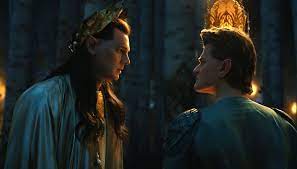Actor Lee Pace, who plays Thranduil, the ruler of the Elves, talks about how his encounter with Mount Doom in New Zealand convinced him that elves existed. The Hobbit movies recount the tale of Martin Freeman’s Bilbo Baggins and his adventures with a gang of Dwarves and act as a sort of prequel trilogy to Peter Jackson’s The Lord of the Rings. Bilbo and his traveling companions come into contact with various wild animals. Still, they also have a few run-ins with Elves, starting in 2012 with the publication of The Hobbit: An Unexpected Journey. As the Elvenking of Mirkwood who openly despises Dwarves, Pace’s Thranduil adds a certain kind of prickliness to the series.
In a Vulture interview, Pace describes an encounter that led him to think that elves actually exist while filming The Hobbit in New Zealand. The actor recalled going on long hikes to the location where Peter Jackson shot The Lord of the Rings’ Mount Doom scenes and losing his phone, which subsequently produced an intriguing discovery. When questioned about whether or not he believed in elves, Pace responded as follows:
Well, I’ve got proof. When I was shooting The Hobbit in New Zealand, I would always go on a big hike where I would backpack and camp. I did Lake Waikaremoana, and I did the Tongariro Northern Circuit, which is about a five-day hike that takes you basically up to where they shot Mt. Doom. I was taking pictures with my phone, and on the second day I reached for my phone and I couldn’t find it. And I thought, ‘Oh, f–k! I’ve lost my phone and I’ve got four more days. I can’t turn back; I’ve got to keep walking!’ So at night, when I was making camp, I’d tear apart my pack, looking for my phone, thinking, It must be in here somewhere! It must be in here! Three days go by, the phone is nowhere to be. I mean, I’ve lost it. I’m certain I left it back there. But I woke up the last night and the screen is stuck to my back. Elves. That’s elves! They said, ‘Son, you don’t need that here! We’re going to take that technology away from you! You need to think about other things. Look around, be where you are, you don’t need that phone. It will not help you.’ So they took it away from me for a while. But they’re not evil, so they gave it back. Is that not proof?
One of Jackson’s LOTR movies’ strengths is how well it brings Middle-earth to life
It is commonly known that Jackson’s native New Zealand served as the location for the back-to-back filming of The Lord of the Rings films. The diverse range of stunning scenery that New Zealand has to offer was ultimately essential in bringing the world of Middle-earth to life. With its enormous mountain ranges, undulating hills, and eerie forests, the nation lends authenticity to J.R.R. Tolkien’s fictitious world and essentially takes on a personality of its own. The Lord of the Rings trilogy was also shot in New Zealand, and the Hobbit trilogy features many of the same stunning vistas, but Jackson takes some choices in the new trilogy that aren’t always popular with viewers.
While Jackson also placed a strong priority on filming things as practically as possible, The Lord of the Rings movies also has a number of groundbreaking (for the time) visual effects sequences that mainly still hold up today. This includes designing tiny sets for places like Rivendell, Minas Tirith, Helm’s Deep, and Barad-dûr as well as using makeup and prosthetics to mostly create Orcs and other animals. Jackson really constructed the majority of Hobbiton amid New Zealand’s verdant hills. Jackson relied much more heavily on CGI in The Hobbit to create specific settings and characters, which resulted in a very different visual approach although still utilizing a lot of natural landscapes and the Hobbiton set.
The way Jackson chose to depict Middle-earth makes the original The Lord of the Rings movie, which is now more than 20 years old, hold up astonishingly well today. The Hobbit trilogy was undoubtedly endearing in its own unique manner, but many fans ultimately felt let down by how much it relied on special effects. The Rings of Power TV series has split viewers in many ways, but it has succeeded in bridging the gap between The Lord of the Rings and The Hobbit trilogies in terms of its portrayal of Middle-earth by fusing real-world elements and CGI with breathtaking results.
